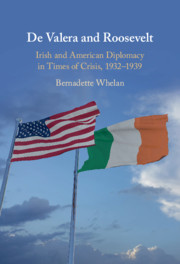Book contents
- De Valera and Roosevelt
- De Valera and Roosevelt
- Copyright page
- Dedication
- Contents
- Tables
- Acknowledgements
- Part I Soft Diplomacy and the Diplomat
- Part II New Regimes Settle In
- 5 Transatlantic Migrant Tide
- 6 De Valera’s Ireland
- 7 Roosevelt’s America
- 8 Common Worlds, 1939
- 9 Conclusion
- Book part
- Bibliography
- Index
8 - Common Worlds, 1939
from Part II - New Regimes Settle In
Published online by Cambridge University Press: 15 December 2020
- De Valera and Roosevelt
- De Valera and Roosevelt
- Copyright page
- Dedication
- Contents
- Tables
- Acknowledgements
- Part I Soft Diplomacy and the Diplomat
- Part II New Regimes Settle In
- 5 Transatlantic Migrant Tide
- 6 De Valera’s Ireland
- 7 Roosevelt’s America
- 8 Common Worlds, 1939
- 9 Conclusion
- Book part
- Bibliography
- Index
Summary
Ireland, a small state, and America, a great power, had little in common by 1938–9. But on the eve of the Second World War, security needs brought interaction between the two countries. Both states intensified military preparedness. But the London factor was influential again during negotiations when the American government agreement to sell arms and equipment was with British approval. The chapter concludes that the inevitable inclusion of Ireland in the US-defined war zone illustrated again de Valera’s misunderstanding of US foreign policy concerns. This gap between reality and aspiration was highlighted throughout the war also as Ireland adhered to neutrality while US neutrality was abandoned in 1941 proof also of the differing needs of a small vulnerable state and a great power and their respective leaders.
- Type
- Chapter
- Information
- De Valera and RooseveltIrish and American Diplomacy in Times of Crisis, 1932–1939, pp. 311 - 355Publisher: Cambridge University PressPrint publication year: 2020

